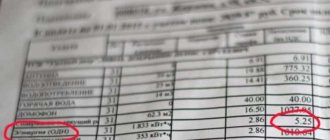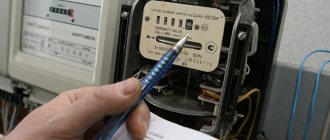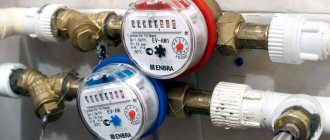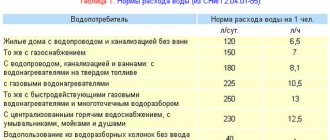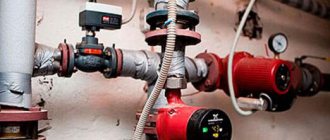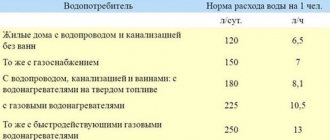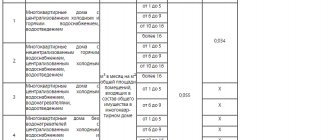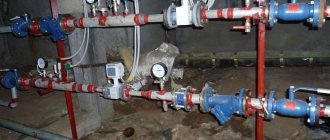The concept of one
What is ODN? Photo No. 1
In 2013, by Government Resolution No. 314, the concept of one water tax was introduced into the utility payment system. This abbreviation is interpreted as general house water consumption needs.
According to the above regulatory document, general house water consumption needs relate to its use not by specific consumers, but for the maintenance of the entire multi-apartment building.
Let's figure out what ODN is.
As you know, cold and hot water enters an apartment building, where it is distributed through utility networks to all consumers. But some of it does not reach due to technological or other problems.
Technological problems mean losses due to various leaks, flushing of utility networks during their diagnostics and other processes.
Other cases mean the use of process water for the maintenance of the multi-story building itself (watering lawns, washing staircases, use for other needs). Based on this, a certain cubic capacity of water enters the house (maximum value), and a smaller portion reaches consumers.
Naturally, the utilities that supply the water must receive payment for all water.
As you know, ODN applies not only to cold, but also to hot water.
The components of cold water ODN are as follows:
- watering the common area;
- use of water resources for washing staircases, as well as other common areas for residents;
- technological loss, such as leaking utility lines;
- other needs for maintenance of an apartment building.
Components of hot water:
- flushing the heating system before starting it hot;
- filling engineering systems with process hot water for their diagnostics;
- troubleshooting problems in which you have to drain hot water and bleed it.
Now let's move on to considering the question of where payments for one-way tax are received. These are utility companies that provide cold and hot water supply services. They are the providers of such public services, and accordingly are required to receive payment for them.
It is important to remember that due to the fact that general household needs for water consumption are classified as public services, they are also subject to the rules on the provision of subsidies.
Where to go for recalculation?
Statement of claim for the provision of utility services for hot water supply of inadequate quality and a reduction in fees for hot water. You can learn how management companies make money by supplying hot water at insufficiently high temperatures from the video: Did you like the article? Follow site updates on VKontakte or Twitter.
We recommend reading: How to register a person in your apartment, how much to pay
Government Decree No. 354
When checking the condition of the metering devices, it may turn out that the metering device is in good condition, for example, the seals on it are not damaged, but its readings differ from those that the consumer submitted to calculate the cost of the utility service for the billing period preceding the inspection. After recalculation, it may turn out that the consumer did not pay for the service in full or, conversely, overpaid for it. In the first case, he may receive a requirement to pay an additional fee, and in the second - a notification of an overcharged fee.
We will talk about the most interesting issues for consumers of utility services that are resolved by the “Rules for the provision of housing and communal services”. Naturally, they are associated with the formation of the cost of utility services and the ability to recalculate in the event that these services were not provided or were of poor quality.
In 2021, it is planned to increase the cost of one-way tax by at least 3-7%. The total amount that residents must pay depends on the area of the apartment. Late payment may well result in penalties and seizure of bank accounts. The components of the ODN will not change in 2021. An increase in tariffs is possible, but it must be fully justified by the management of management companies. According to the government, by removing ODN from the list of services provided and including its cost in total costs, citizens will no longer be confused in calculating utility bills. All restrictions implemented and planned for introduction are carried out on the basis of Resolution 1148. General household needs will disappear only from the receipt, and their cost will be included in the total amount. Homeowners and tenants will still have to pay them.
By the way, there are a lot of such optional or rather deferred obligations in the Russian housing complex! Management companies stubbornly do not want to carry out all the procedures for installing general meters (not to be confused with the installation of meters, organizational measures are also required). In the next step, it will naturally be necessary for the owners to keep control over the verification of the TT, as well as everything else when applying PP-354.
From January 1, 2021, the procedure for paying for general household needs will change.
The law states this simply and, at first glance, understandably: the costs of maintaining the property that, as it were, belongs to the residents of a particular house. So, if this is one water supply, then this is washing entrances and staircases; if this is one for heat, then this is heating of entrances; if this is one for electricity, then these are light bulbs in the entrances; and so on.
The concept of general house needs is defined in the Decree of the Government of the Russian Federation of May 6, 2021 No. 354 “On the provision of utility services to owners and users of premises in apartment buildings and residential buildings.” These are costs associated with resources that were used outside of residential premises. This applies to common areas - elevators, entrances, stairwells, dryers. In the process of their maintenance, not only the restoration of cleanliness and order occurs. A certain amount of resources is spent on these places. This is the general needs of the house. Costs are calculated quite simply. The basis is the total volume consumed for the reporting period, based on the readings of individual metering devices. It excludes resources used by residents of the premises. The difference will be the desired figure.
Frequently asked questions regarding the calculation of ODN standards
Answers on payment for one-time tax. Photo No. 3
Despite the fact that this tariff was conceived as a payment for water resources that are used for the maintenance of houses, it is not formed transparently, which is why many utility companies try to inflate the consumption standards of ODN.
Let's look at frequently asked questions. The first concerns calculation schemes. There are several formulas for calculating ODN, but none of them are perfect and there are many ways to confuse consumers.
It’s easier for those who have an apartment building equipped with a common building meter for cold and hot water. Having it, utility consumers can always compare how much water entered the house, as well as the amount spent by all consumers. Accordingly, the difference will be the amount of one.
Those houses that do not have communal metering devices will pay for ODN based on calculations from utility service providers. The formula for them is as follows - H = 0.09 x K / C.
N is the value of ODN for a specific consumer facility (that is, for one personal account), 0.09 is a standard number used for all calculations, K is the total number of citizens living in the house, C is the total value of all residential and non-residential in a particular apartment building home.
As can be seen from this formula, it will not reflect an accurate indication of the water used to service the house and its utilities.
The next question concerns payment for services not provided. For example, there are situations when there is no water in the house due to repair work on the central water supply, or other breakdowns, and the received payment contains one. No need to panic. It is enough to submit a statement in the form of a claim to the utility company supplying water.
In it, indicate from what time and for what time there was no water, and ask for a recalculation, which can be checked using the above formula. If such a recalculation is not done, then you can contact and demand that it be done forcibly.
Starting from 06/01/2017, residents of Russia pay for general household needs at new tariffs. The resolution on reforming the calculation of payment for single income tax was adopted in order to make the calculation of this parameter more transparent and eliminate the possibility of its intentional overestimation by management companies. What does this mean for each of us, and what consequences should we expect?
To begin with, let us recall that the first stage of reform of the system of accrual of general household needs passed from January 1, 2021. Previously, ODN was a separate column in the receipt of any resident of a multi-storey building, but since the new year this parameter is automatically taken into account in the total amount payable for certain utility needs. The basis for calculating the payment amount was the consumption value of each resident, calculated according to the standards. They are established by local authorities of republics, regions and territories.
Dear readers!
Our articles talk about typical ways to resolve legal issues, but each case is unique. If you want to find out how to solve your specific problem, please contact the online consultant form on the right →
It's fast and free!
Or call us by phone (24/7):
Take a sociological survey!
Differences in the methodology for calculating and the cost of common building needs are determined by whether the apartment building is equipped with a collective utility metering device or whether the residential/non-residential premises of the building are equipped with individual or common meters.
Calculation according to standards
Previously, resource providers could suspend or completely stop providing services to the consumer. However, based on changes in legislation, the Supreme Court clarified the issue of the legality of such actions. Resolution of the Supreme Court dated June 27, 2021 N 22 contains a clear explanation that depriving defaulters of light, heat and water are measures disproportionate to non-payment.
The implementation of these works involves a large consumption of water, and service providers have the right to enter it into general house accounts and distribute it among the owners, according to the square meters of the occupied area. It is assumed that the payment for general house needs for hot and cold water will correspond to the actual supplies carried out by service organizations.
In any case, household services use a resource such as electricity. They used to include it in the one-room supply system earlier than water. For the first time, such an item could be found in receipts for 2021. Previously, residents also paid for electricity consumption in common areas.
What is written in the ODN column
Resolution 354 requires the housing resource provider to provide the consumer with payment documents, which must contain data reflecting all expenses. The payer must see what he is paying for to the supplier who supplies the house with water, electricity and other resources. Utility bills when paying for general house needs must contain:
Because of this, for residents of some buildings with motion sensors, modern elevators and insulated entrances, the cost of maintaining common property has increased since January 1. For example, last year the management company calculated general house needs according to its scheme, took into account energy-saving measures and actual consumption. And starting this year, I began to calculate general house needs according to the standard - as written in the law. Due to misinterpretation of the law, tenants are forced to pay more.
For example, you can use LED bulbs and motion sensors in entrances to save energy. If you install a closer on the front door, it will not be open in winter - heat loss will be reduced. The house must have a common house meter in order to pay for actual consumption, and not according to standards. Your management company should be responsible for all this.
We recommend reading: How to find out the expiration date of a foreign passport by knowing its number
How do I know that I am not overpaying for the maintenance of common property?
Until January 1, 2021, general household needs were indicated on receipts as a separate line. Management companies calculated these payments differently, and no one regulated the standards. In one house, residents paid 200 rubles for light in the entrance, and in another - 1000 rubles.
Start-up and adjustment measures are carried out only after the following data has been clarified:
- compliance with the serial number of the device specified in the passport;
- identity of the meter and technical documentation, configuration, installation diagram;
- meter functionality.
Federal legal acts limit the billing period for utility products to one month, but the amount of the contribution is set by the service provider, taking into account territorial conditions and some surcharges.
Rights and obligations
Decree number 354, as recently amended in 2021, on public services regulates the resolution of conflict situations. Many controversial positions arise due to incorrect calculation of payment for utility services, or the latter are not on time or do not perform functions in the departmental economy.
In a situation where more people than registered actually live in an apartment and consume water, the problem of “rubber apartments” arises. If there are a lot of them, general house meters may show consumption 1.5-2 times greater than provided by the standard.
Decree of the Government of the Russian Federation No. 354 on the Rules for the Provision of Public Utilities, which regulates the calculation of one-time tax for water in 2021, preserves the principle according to which consumers pay for consumed resources according to the readings of collective metering devices.
Formula components
The total needs in the presence of a meter are the difference between the value shown by the common house meter and the total sum of the values of individual meters, together with the costs according to the standards in premises not equipped with meters. The resulting result is distributed in proportion to the occupied area among all owners. Accordingly, regardless of the number of people living in a multi-room apartment, the cost of one-room apartment will be greater than for a one-room apartment.
For many city residents, utility tariffs are quite high, so they carefully monitor their expenses so as not to overpay. Often they have a question about why the item “general household needs” (CHN) is included in the receipt. What kind of expense is this?
Calculation and payment of general house needs occurs in two ways. If multi-storey residential buildings have collective metering equipment - meters for hot/cold water, electricity and heat, then calculating the general needs of the building and distributing it among consumers is quite simple.
General house needs and heirs of Ostap Bender
Calculating ODN begins with finding out whether the apartment building has a meter. If there is, then the difference between the indicators of the device and the residents’ counters is calculated. They are then distributed proportionally among homeowners. This proportion is determined using the area of the apartments.
If the MKD is equipped with an ODPU and previously the fee was calculated according to its readings, the Ministry of Construction of the Russian Federation considers it possible to charge a fee in an amount lower than the established standard, based on the actual consumption of utilities at the ODPU.
How was the amount payable calculated?
One credit is awarded based on simple mathematical calculations. The calculation takes into account the amount of utility resources provided by the management company and the amount of consumption by residents according to individual meters. To simplify understanding, we will illustrate the situation with a specific example. The management company supplied 6,000 kW of electricity to the residential building. At the same time, the amount for all residents’ meters was 5000 kW. Accordingly, 1000 kW was required for general house needs.
In this case, payment for one electricity supply is evenly distributed among all residents on a proportional basis. The total amount of ODN (1000 kW) is divided by the area of the house, and then the resulting number is multiplied by the square footage of the specific apartment. This way it becomes clear how much each resident owes. This amount is automatically added to the amount due according to the individual meter readings.
Why was the reform needed?
According to Deputy Minister of Construction and Housing and Communal Services of Russia Andrei Chibis, residents of multi-storey buildings were previously forced to pay receipts for significantly inflated amounts. This was the result of fraud on the part of management companies, and it was almost impossible to prove it.
On the other hand, in accordance with the January reform, the calculation of ODN should have been carried out only according to meters, and not according to inflated standards. Therefore, by January 1, 2021, the task was set to equip multi-apartment knowledge with common building meters. It was also important to exclude the possibility of misuse of resources. This problem is caused by two main factors:
Increasing the energy efficiency of servicing residential buildings, together with their equipment with meters, should have increased the transparency of the accrual of ODN.
Lawyer Anisimov Representation and defense in court
Federal legislation provides for the same liability for refusal to pay for general household needs as for refusal to pay for energy consumed in an apartment. Both payment for ODN and payment for intra-apartment electricity consumption relate equally to the energy supply service.
No. Each citizen pays for consumption according to his individual metering device installed in his apartment, and his share of the general household consumption, determined in accordance with the Rules for the provision of utility services.
Rules for calculating ODN - with and without a counter
While the widespread installation of meters in each apartment, as well as a common meter per house, remains an unrealized prospect, options for paying for one-time tax are provided for residents of buildings that, for some reason, do not have meters. This is especially important in the case of calculating the amount for heat and light, because each resident’s consumption of this resource is purely individual, unlike, for example, heat consumption.
Above we looked at the calculation rules for installed meters. But if there is no way to navigate by instruments, then the uniform tariffs established by the state come first. They are approved at the local level, taking into account the characteristics of each region. One of the urgent tasks of management companies is to inform residents of controlled buildings about these tariffs. Therefore, if you want to calculate how much you need to pay by checking whether the receipt corresponds to reality, feel free to call the management company and request information from the operator.
When calculating, the consumption standard is multiplied by the area of all common areas of the building, as well as by the area of the apartment, and then divided by the total area of all apartments in the house.
Water disposal for general house needs
The judge cancels the court order if the debtor raises objections regarding its execution within the prescribed period. In the ruling on the cancellation of the court order, the judge explains to the claimant that the stated claim can be presented by him in the manner of claim proceedings. Copies of the court ruling to cancel the court order are sent to the parties no later than three days after the day it was issued.
4. In the house where the pensioner lives there are no technical means for drainage for general house needs. There is only a communal water meter, which takes into account the water consumption of all apartments in the building. Thus, for those who have a water meter, payment for water is added for those apartments that do not have meters. How to challenge the water utility's demands for payment of ODN? Thank you.
What has changed since June 1, 2021?
The repeated reform after just six months was dictated by the fact that the initial changes, unfortunately, did not affect the purity of calculations at . Since building-wide devices for metering consumed resources are not installed everywhere, management companies took advantage of this, forcing residents to pay much more than the norm. Managers also saw another loophole for dishonesty in setting standards at the local level - they were artificially high so that people would pay more. Moreover, in some management companies they ignored the requirement to calculate ODN using communal meters. Even if they were available, the basis for calculating the amounts to be paid was taken to be state standards that were previously deliberately inflated.
Now the standards will be calculated depending on the total consumption of each home. Consequently, management companies are deprived of the opportunity to redistribute the value of lost resources between residents.
The main change concerned responsibility for resource consumption in excess of the established norm. Now, if it happens that one house uses more light, water or heat than is prescribed in the regulations, then the management company, not the residents, must pay the difference. Suppose the standard prescribes the consumption of up to 100 cubic meters of water per month by one house, but in fact 150 cubic meters were spent. Then the management company undertakes to pay the difference of 50 cubic meters in favor of the utility company providing water supply.
What to expect from the reform?
Thus, the standard automatically becomes the highest point of resource consumption, and no one will force residents to pay more. If a common house metering device records the amount of TDS lower than the standard, management companies are obliged to rely on this indicator when issuing bills to residents.
This change will allow:
Separately, we note changes in payments for electricity. To streamline the calculations and make them more realistic, two changes were made:
- General standards have been reduced;
- For houses equipped with elevators and electric heating or electric heating installations, the calculation of hot water supply will be carried out according to different standards during and outside the heating season.
We especially note the second point of changes in the payment for one-time electricity charges. Now the amounts in the receipts of residents of premises with electric heating and heating devices will be extremely close to reality, because it is obvious that in different seasons it will be necessary to spend different amounts of utility resources to meet the general house needs of such premises. Thus, in the summer it will now be possible to avoid overpayments in comparison with the situation with an initially inflated tariff to equalize year-round payments, and in the winter management companies will receive enough money from residents to provide high-quality maintenance of houses.
Will there be more changes?
In the foreseeable future, the system for calculating ODN may again be reformed. Similar to the breakdown of payments for light in houses with electric heating devices, it is planned to revise the standards for houses with an elevator and a boiler. Obviously, meeting the general building needs requires large resources, and therefore the standard should be higher than that of houses without elevators and boilers. However, for now it is set at a single level at the regional level.
All this allows us to hope for the successful completion of the procedure for optimizing payments for utility bills not only at the country level, but also in each individual home. Management companies are forced to act strictly within the law, and although they still have certain loopholes for increasing fees from residents, with each addition to the ODN reform they become fewer and fewer, and at the same time the standard of living of every resident of Russia increases.
Dear readers!
It's fast and free!
Or call us by phone (24/7).
Probably, all people living in high-rise buildings and using the services of public utilities have already managed to appreciate the changes that have been made to the calculation of one-time tax from January 1, 2021. Let’s be honest, people didn’t like these changes much, since the amounts in payments were noticeably higher than it was before. It’s not surprising, because if the industry begins to live by new rules, it means that those who are responsible for it need it. But people like such changes much less often. But there is nowhere to go, since there is little we can do to influence what is happening, so we have to adapt and study the changes that the law regulates.
By the way, for those who don’t know, ODN is translated as general house needs. That is, benefits that, in theory, all residents enjoy. This includes heating, water supply, electricity, cleaning, garbage removal, work in the local area and more. You have to pay for all this, and each of the residents of the house does this. Some pay more, some pay less, but payments arrive regularly. But as a responsible citizen, every person must understand what the changes are and how their presence will affect the costs of apartment owners.
Dear readers!
Our articles talk about typical ways to resolve legal issues, but each case is unique. If you want to find out how to solve your specific problem, please contact the online consultant form on the right →
It's fast and free!
Or call us by phone (24/7):
General house electricity needs
in a house without an elevator - 1 kW/hour in a house with an elevator - 1.2 kW/hour in a house with pumping equipment for pumping water and heating - 1.3 kW/hour in a house with an elevator and a pump, respectively 1.5 kW/hour It should be noted that the standards have increased 6-10 times since June of this year!
Contact your property manager with a free-form application (don’t forget to leave your contact details), and together with the management company and representatives of the residents, the legality of connecting the shoe shop will be checked. If unauthorized connections are detected, the charge for one-way access will be recalculated for both residents and legal entities located in the apartment building, depending on the connection scheme.
Changed ODN from January 2021
The country’s housing and communal services industry can hardly be called particularly advanced because, despite the decent funds that people give as payment for services, nothing changes. Money disappears, and most citizens continue to live in real pigsties. If apartments can still be maintained in relative order, then, unfortunately, the same cannot be said about the entrances.
It is not surprising that the housing and communal services sector began to be jokingly called a black hole, because all matter is also sucked into it, and, in fact, there is no return. But they decided to change the ODN in 2021, in the hope that after this the crisis will disappear. We, of course, strongly doubt it, but the fact remains a fact. Now residents of high-rise buildings have to pay for utilities provided to the entire building. That is, the principle is simple - you pay for your utilities, and then you still have to pay the rest, which goes to the whole house, to lighting the entrance, heating and more.
If you believe what the law says, then the new tariffs are designed to rationalize costs so that users do not overpay. In fact, this is another plus to the communal apartment. But many are willing to pay, only so that the utility companies actually do their job, and not just complain that they don’t have enough money and still need to make a couple of payments for the common good.
Now about the procedure itself:
The main goal of the law under consideration is an attempt to create the conditions necessary to increase the efficiency of the housing and communal services sector and improve the payment discipline of clients. By the way, the tariff itself is individual for each region, so users should not count on the same payments.
Prerequisites for making changes
We all understand that no one will simply change the law. There must be serious reasons for this, and in this case there were and are. The fact is that utility prices for 2021 were, to put it mildly, inflated. In addition, people paid, but the results of what they paid for were not noticeable. Naturally, such a situation caused nothing but outrage.
The first steps towards a solution were taken back in 2015, but at that time it was impossible to carry out a complete reform for a number of reasons. But the authorities managed to well prepare the legislative framework, which only remains to be implemented. The implementation process has been postponed to 2021. From the very first day of the year, the new rules gradually began to be implemented. They concerned changes to Article 154 of the Housing Code of the Russian Federation.
In order not to bother anyone with an abundance of legal terminology that no one needs, we will try to highlight the very essence of what changes were made to the law. More precisely, what parameters it covers. After all, this is important if you need to calculate what exactly to give your money for.
- Caring for the premises, that is, the entire house;
- Home repairs, which, according to the letter of the law, will be carried out regularly;
- Cold and hot water supply service;
- Service for supplying electricity to non-residential premises of a multi-storey building;
- Thermal energy, including that used for repair and maintenance of the heating system, etc.;
- A service for the removal of sewage water used for normal operation of the house.
Simply put, people will now pay not for the services provided to them, but for almost the complete maintenance of their home. This is a more labor-intensive process, which naturally requires more money. But the main thing is that these funds really go to good use, and that utility employees do their job well.
Water disposal for general house needs, judicial practice
An employee of a housing cooperative undertakes to pay utility bills after he is provided with residential premises for use from the housing society. When ownership of real estate arises, the owner is responsible for paying utility bills, that is, when the property is registered in the manner prescribed by the state.
In addition, homeowners need to pay for consumed resources using installed metering devices. If the premises are not used by the owners, then this is not a legal basis for non-payment of utility bills. A sample agreement on restructuring debt for utility bills will help you draw up the document correctly. How much are utility bills in private house? Interested in the amount of utility bills for major repairs in 2021? When the owner of the premises has been absent from the apartment for a long time, you can use the recalculation procedure. This applies to utility bills, which are calculated according to established consumption standards, that is, according to meters. Recalculation is carried out according to the established share of the owner in the apartment. Recalculation can only be issued for some utility payments - cold and hot water, electricity, gas and sewerage.
How is ODN calculated from January 2021?
Interesting changes have taken place since the winter of this year. Now you can forget about the mysterious line ODN, which has been an eyesore for apartment owners for quite some time. The unit of expenditure in question, which was previously separate, is now included in the general item, that is, it has begun to be part of the fee for. Therefore, the line fee for ONE will disappear. But how can you control its size? No way. We must trust public utilities. But somehow it doesn’t work.
To common property, according to Art. 36 clause 1 of the Housing Code of the Russian Federation, you can include rooms that do not belong to part of the apartments and are used as common property. This category includes:
- The elevators themselves and elevator shafts;
- Technical floors of houses, roofs;
- Staircases, corridors between apartments and more;
- Basements and attics, the normal condition of which must be paid for;
- Engineering Communication;
- Caring for the land on which the house stands. This item includes landscaping elements located in the local area (playgrounds, flower beds).
As for the indicators of devices, they are calculated very simply - taking into account the general house indicator, subtracting the payment that is shown by ordinary apartment meters. So the payment for ODN does not depend on exactly how the residents act, or on how well the utility services perform their duties.
ODN is the norm that is paid everywhere in order to minimally maintain the property in good condition. But now that this separate expense item will not exist, it is much more difficult to control its size. Claims arose because utilities began to abuse their powers. The following was invested in this account:
- Management organizations included their debts to resource suppliers into this account, trying to “recapture” money from people’s pockets;
- Payments include third-party expenses of suppliers, which in no way relate to the quantity or quality of services provided.
Resolution No. 354 - General house needs - to pay or not to pay according to the Law
- Staircase landings.
- Stairs.
- Elevator facilities, including the elevators themselves, shafts.
- Other structures associated with the house.
- Corridors. Technical floors.
- Attics, basements.
- Engineering Communication.
- Equipment that serves more than one room.
- Roofs.
- Premises that do not belong to a separate owner, but serve to satisfy household or social needs, for example, a gym located in the house.
- Structures, load-bearing, as well as non-load-bearing, enclosing.
- The plot of land on which the house is located.
- technical losses in engineering communications (intra-house) water supply, electricity, gas, heat, house equipment. These include losses that occur during accidents, flushing of systems, filling them, testing;
- cleaning, cleaning (sanitary and hygienic) of common premises;
- improvement of local areas and their maintenance;
- lighting entrances, as well as attics and basements, basements, providing them with heat;
- operation of elevators and other equipment, for example, intercoms.
We recommend reading: Disabled person with 1 degree of vision, what is the pension after 80 years
How to calculate ODN for electricity in 2017
Electricity indicators, as a rule, are among the most expensive, which is why it is necessary to correctly calculate what part of the amount in question will go into paying for general household needs. Naturally, users are interested in this, because payments for single-use apartments have increased since January 2021, not just by a paltry two times, but in some cases by six times, which does not please residents of high-rise buildings at all.
So, let's talk about how to calculate utilities for electricity:
- The first option is the simplest, as it is used if each apartment has a personal meter. Then the formula looks like this:
ODPU readings - Electricity consumption for general house needs - IPU consumption - Consumption according to the standard * Apartment area/Area of all apartments in the house
The formula seems long, but in reality everything is quite simple, since the electricity of one building is determined in proportion to the area of the room in which a person lives (apartment), to the total area of the building and to the balance of consumption in the high-rise building, which was not paid for by personal payment.
This situation complicates the calculations a little and opens the door to fraudulent schemes. Therefore, you should not be surprised that after users install a meter, the numbers in their payments will drop significantly. But if this is not yet possible, it still wouldn’t hurt to find out exactly what formula is used to calculate the numbers in question.
The calculation procedure takes place using official standards for electricity consumption for general household needs. This formula looks like this:
Consumption standard * Area of common premises * Area of apartment/Area of all apartments in the house
In more detail, the rules for calculating one-time tax for the case under consideration are as follows:
- First, the share of electricity used in the single-circuit generator is calculated;
- The previous unit is added to the volume of electricity calculated according to the IPU or standard, depending on the circumstances;
- A receipt is drawn up and sent to the property owners.
But the payment will not be indicated as a separate unit, but will be included in the total cost, so the person needs to pay utilities in full.
Calculation of wastewater consumption standards for general house needs
This is proven by judicial precedent, which came into force by the Decision of the Arbitration Court in case No. A60-65129/2021. This legal document confirms the legality of accruing costs for ODR for wastewater disposal. The decisive point, according to the court, is the inclusion in the payment of OA expenses of the costs of acquiring all the necessary utility resource components. This also includes drainage services, but with the condition that the apartment building has internal utilities that drain wastewater from the building.
We recommend reading: Where to write if you are not accepted into kindergarten and have written an application
This formula takes into account the amount of a certain deduction, which is paid under another utility item. These deductions include the amount of water spent on flushing the internal heating system and emergency losses.
How to calculate ODN for heating in 2021
If in the summer we look for coolness, then in the winter cold radiators turn into a real disaster, threatening an eternal runny nose or something more serious. But if you don’t pay for utilities, in particular, don’t pay for heating services, then you will soon be able to get acquainted with permafrost.
Thermal energy is also calculated in a new way from January 2021. Here is the formula that shows the changes in the calculations:
Apartment area * Heat consumption standard for the heating season (Gcal/m²) * Heat energy tariff;
And here are the calculations of the payment for heat in communal premises.
Judicial practice on general household needs
Payments for utilities in common areas are calculated in accordance with established consumption standards for general house needs. Management organizations cannot write off to residents all costs for heat, water and electricity calculated by common house meters, and residents do not pay more for common house expenses than they spend in their own apartments.
By the ruling of the Moscow City Court of the Moscow Region dated In case No. 33-48242/2021, the decision of the Dorogomilovsky District Court of Moscow to satisfy the claim of the management company against the owner of a house in a cottage village for providing a range of services for the technical maintenance and cleaning of public roads, including current repair of road surfaces; care of organized green spaces on public lands; cleaning of common areas; removal of consumer household waste; maintenance of fencing of the territory of the cottage village; organizing access control and maintaining order on the territory, which includes: operation of a checkpoint; preventing unauthorized persons from entering the village. The appeal ruling of the Moscow City Court in case No. 33-34021/15 overturned the decision of the Ostankino District Court. I inherited from my father a plot of land in an elite cottage village in Moscow, which collected payments for maintenance of general infrastructure. At that time, I was in prison. Studying these judicial acts reveals the following important points: Perhaps these judicial acts will be the beginning of a new stage in the relationship between home owners in cottage villages and management companies, and the interests of the owners will be adequately protected. After my return, the management company accrued a debt to me for maintaining the site, security, landscaping, etc. The contract for the provision of services to the management company may have been signed by the late father, I have not found it. I do not help residents fight against the management company, which I accompany and will not accompany the management company if I have an agreement with its resident. Are the demands of the management company excessive and unreasonable? it amounted to half the cost of the plot, although there is not even a house on it. Can I not pay the debt during my absence, since I was actually deprived of the opportunity to use it? And I will not enter into a support agreement with a management company if it has a conflict of interest with another management company that I already serve. You claim that you can “defeat” the management company, which filed a claim for recovery for major repairs, general house needs and current repairs. The same claims can be presented to a lawyer who provides services for divorce or division of property for both husbands and wives. The management company showed an agreement for an apartment building for 5 years, approved by part of the residents of apartment owners by absentee voting, but there is nothing there regarding major repairs, general building needs and routine repairs.
We recommend reading: Rosstat division code

